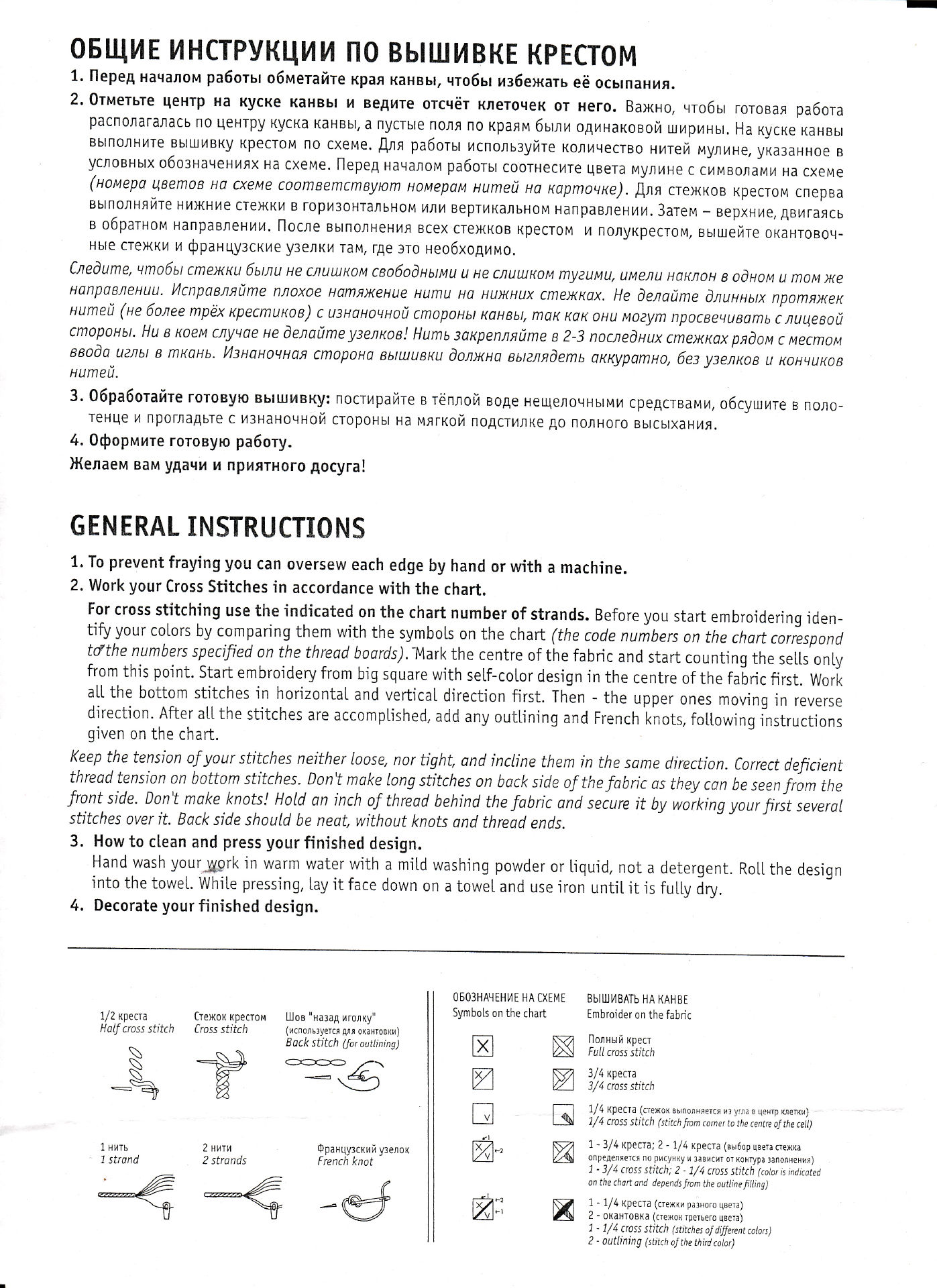M157 i

OELUME MHCTPyKUMM no BbllllMBKE KPECTOM
1. riepefl Hana/ioM pa6oibi oÓMeiaMTe Kpan KaHBbi, mo6bi M36e>KaTb ee ocbinaHMn.
2. OTMeTbTe 4eHTp Ha Kycne KaHBbi u Beflme otcmct K/ieTcmeK ot Hero. Ba>KHo, HTo6bi roTOBas pa6oTa pacno/iaraAacb no pempy nycna KaHBbi, a nycTbie no/ifl no Kpa/m 6buw OAMHaKOBOM mnpnHbi. Ha Kycne KaHBbi BbinoiiHHTe BbiiiiHBKy KpecTOM no cxeMe. fl/ifl paóoTbi ncno/ib3yMTe KO/iMHecTBo Hmen My/iMHe, yKa3aHHoe b yc/ioBHbix o6o3HaHeHMflx Ha cxeMe. flepeA Hana/ioM paóoTbi cooTHecme pBeia My/iMHe c CMMBO/iaMM Ha cxeMe (HOMepa peemoe Ha cxeMe coomsemcmBytom HOMepau Humeu Ha KapmoHKe). fl/ia de>KKOB KpecTOM cnepBa BbinO/IHHMTe HMJKHMe CTe/KKM B mpH30HTa/lbH0M I4/1M BepTMKa/lbHOM HanpaB/ieHMM. 3aTeM - BepXHHe, ABUraflCb b o6paTHOM HanpaB/ieHMH. nocne Bbmo/iHeHMA Bcex de>KKOB KpecTOM u no/iyKpecTOM, BbimeMTe OKaHTOBOH-Hbie CTe/KKM m cj}paH4y3CKMe y3e/iKM TaM, rAe sto Heo6xoAMMO.
Cnedume, ymoóbi cmewKU 6bmu He cmjhukom CBOÓodnbiMU u He cjiulukom myeuMU, uuejw hok/ioh b odHoiw u moM we HanpaB/ieHuu. kicnpaB/iHume nnoxoe HamaweHue Humu Ha hu>khux cme>KKax. He denaume d/iuHHbix ppomaweK Humeu (He 6onee mpex KpecmuKOB) c u3HaH0HH0u cmopoHbi KaHBbi, man kok ohu Moeym npoceeHUBamb cnupeBOU cmopoHbi. Hu b KoeM cnynae He denaume y3e/iK0B! Humb 3aKpennaume b 2-3 nocnedHux ane>KKax padoM c wecmoM BBoda usfibi b mKaHb. M3HaHOHHafi cmopOHa BbtiuuBKu dojUKHa Bbizjifidemb aKKypamno, 6e3 yoenKOB u kohhukob Humeu.
3. 06pa6oTaMTe roTOByio BbiwMBKy: nocTMpaMTe b Ten/iOM BOAe HeiAe/iOHHbiMM cpeACTBaMM, o6cywMTe b no/io-TeHpe u npor/iaAbTe c m3H3ho4hom CTopoHbi Ha matkom noACTM/iKe ao no/iHoro BbicbixaHMA.
4. Ocf)opMMTe roTOByio paóoTy.
)Ke/iaeM BaM yAami u npwiTHoro flocyra!
GENERAL INSTRUCTIONS
1. To prevent fraying you can oversew each edge by hand or with a machinę.
2. Work your Cross Stitches in accordance with the chart.
For cross stitching use the indicated on the chart number of strands. Before you start embroidering iden-tify your colors by comparing them with the symbols on the chart (the codę numbers on the chart correspond tcfthe numbers specified on the thread boards). 'Mark the centre of the fabric and start counting the sells only from this point. Start embroidery from big square with self-color design in the centre of the fabric first. Work all the bottom stitches in horizontal and verticat direction first. Then - the upper ones moving in reverse direction. After all the stitches are accomplished, add any outlining and French knots, following instructions given on the chart.
Keep the tension of your stitches neither loose, nor tight, and incline them in the same direction. Correct deficient thread tension on bottom stitches. Don't make long stitches on back side of the fabric as they can be seenfrom the front side. Don't make knots! Hołd an inch of thread behind the fabric and secure it by working your first several stitches over it. Back side should be neat, without knots and thread ends.
3. How to clean and press your finished design.
Hand wash yourj^ork in warm water with a mild washing powder or liquid, not a detergent. Roli the design into the towel. While pressing, lay it face down on a towel and use iron until it is fully dry.
4. Decorate your finished design.
1/2 Kpeda Half cross stitch
K
CreKOK KpecTOM LUob '‘na3a,ą urójmy"
Cross stitch (ncnomoyeTcfl rab ok3htobkh)
Back Stitch (for outlining)

1 HMTb 2 HHTH
1 strand 2 strands
0panpy3CKHfi y3e/iOK French knot

0E03HAHEHME HA CXEME BbllUMBATb HA KAHBE Symbols on the chart Embroider on the fabric


rionHbiii KpecT l6XSl Fuli cross stitch
3/4 KpecTa
V/\ 3/4 cross stitch
I j 1/4 KpeCTa (crewoK BwnofiHfleTCfl «3 yrjia 8 uenrp Kjieo<n)
I 3/4 cross Stitch (stitch from corner to the centre ofthe celi)
Ks/3 1 - 3/4 KpecTa; 2 -1/4 KpecTa (bu6op RBeraaeKna l£4i onpeaenseics no pucyHKy u 3ae«cm or Kornypa 3anonHeHUB)
3 • 3/4 cross Stitch; 2 - 3/4 cross Stitch (color is indicated on the chart and dependsfrom the outline filling)
f^ppj 1-1/4 KpecTa (cTew«n pa3Horo uaeia) l^)i 2 - OKaHTOBKa (cTe«0K rperbero pBeia)
3 -1/4 cross Stitch (stitches of different colors)
2 - OUtlining (stitch ofthe third color)
Wyszukiwarka
Podobne podstrony:
M158 i OElflME MHCTPyKUMM nO BbllUMBKE KPECTOM 1. riepefl, Hana/ioM paóoTbi o6MeTa
M159 i OBIUME MHCTPyKUMM nO BbllUMBKE KPECTOM1. riepefl nana/ioM paóoTbi oÓMeTawie
M156 i OBLUME MHCTPyKUMM no BbILUMBKE KPECTOM 1. nepen Hana^OM pa6orbi oÓMeTaiue w
Instr02 (6) MHCTpyKMMfi no c6opKe flaHHyto MOflenb mo>kho BbinonHMTb b flByx CTeneH«x cjio>kho
x7 OÓLUMe MHCTpyKl4MM HO BbllUMBKe KpeCTOM. 1. riepea HananoM pa6oTw o6MeTatiTe Kp
M157 ApT. M157 (20x18 cm). 1/13 cepnn: «JlK>6nMbie nrpyujKM». (CxeMa pa3pa6óTaHa CothhkoboPi Oiib
skanuj0009 (31) No czym polega metoda ochrony, konserwacji i zagospodaiowcnia ruin zamkowych się do
skanuj0011 (310) &nQOy /TTYLFns cdT-no^&tUi -^-cienóUiY *00^ iptfty VEA^‘~ 7r,Jy Ucm./"
więcej podobnych podstron